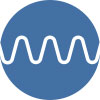Information provided by different companies about the features and specifications of Whole Body Vibration machines is often conflicting and confusing. To understand which features in a vibration machine matter and which features don’t, it will help you a lot to understand how Whole Body Vibration works.
 Key FACT
Key FACT
The way your body responds to a Whole Body Vibration machine is determined by the characteristics of the vibration produced by the machine, which is transferred to your body.
The number of speed levels or vibration modes on a machine, whether it has one motor or two, whether it has a small sized motor or a large sized motor, whether it has handles or not, these are just some examples of features that don’t matter if the vibration produced by the machine is not sufficient to cause a positive response.
Read any of the +2000 scientific research studies involving Whole Body Vibration, and you will see the scientists create an exercise protocol for their experiment. This protocol is documented carefully, so that health professionals and other researchers can reproduce the protocol in order to repeat the experiment for themselves. Included in these protocols are vibration measurements, which are typically measured by the scientists with use of an accelerometer.
Here is an example exercise protocol: Total sessions: 3 sessions per week for 12 weeks Exercise: 8 x 1min squat per session Vibration frequency: 25Hz Vibration amplitude: 6mm Vibration G force: 8g’s
It is only after performing dozens of these studies that scientists can start to see which protocols work best and which protocols fail. In order to be able to use a machine according to the research on Whole Body Vibration, it is crucial that you have verified the frequency, amplitude and G force specifications of your machine.
 Note
Note Many Whole Body Vibration Machines are not capable of producing vibration characteristics which are scientifically supported for the benefits of Whole Body Vibration. Download the FREE WBV MACHINE REVIEW REPORT to see the real output of 57 vibration machines as tested by independent engineers.
The Frequency of vibration is a measure of how many times the platform moves up and down each second. For example, a Hypervibe G17 PRO machine has a minimum frequency of 5Hz (five times a second) and a maximum of 35Hz.
 Note
Note Many Whole Body Vibration Machines either do not display the frequency of vibration or display inaccurate, lower than expected readings. Download the FREE WBV MACHINE REVIEW REPORT to see the real output of 57 vibration machines as tested by independent engineers.
Frequency is important because it affects the way the vibration is transferred to your body and the way in which your muscles respond.

Low frequencies are usually only found in pivotal type machines (see Platform Types) and when running at a low frequency, the term “vibration” is perhaps not an accurate description of the platform motion. At low frequency, the platform causes a slower rocking motion, and as a result there is a large degree of side to side, lateral motion in your body. Subsequently, much like standing on a rocking boat, most of your muscle contractions are made consciously to stabilize yourself.

Repetitive pulses of sufficient energy cause rhythmic muscles contractions. These muscle contractions create a strong pumping effect and result in a huge increase in peripheral blood flow as well as lymphatic drainage. This can be particularly effective for those with poor circulation or swelling in the extremities.Mid frequencies are also usually only found in a pivotal type machines and when running at a mid frequency, the term “vibration” is also perhaps not an accurate description of the platform motion. At mid frequency, the platform is still creating a large degree of lateral motion in your body, but with a noticeable higher intensity and rate of stimulation from the low frequencies, a shaking motion is induced. In fact, it is an industry known secret that mid frequencies, particularly in the 9-12Hz range, create a resonance in the machine and you will notice that the machine itself tends to shake more in this range. The effects of shaking the body is well known in manual therapy techniques for the ability to induce muscle relaxation, improve blood flow to the limbs etc.

Higher frequencies generate a faster platform movement and deliver more energy to your body, certainly higher frequencies can be described as vibration. At high frequency there is very little lateral motion, and although the intensity of the stimulation is increased, the feeling becomes less bumpy and smoother. With increased intensity, the higher frequencies cause the body to grow stronger and provide more stimulation. Due to the rapid rate of stimulation, most of the muscle contractions are involuntary reflexive muscle contractions.
While setting an optimal vibration frequency for training appears to be highly individualized, one thing is very clear; scientists commonly choose to use frequencies between 20-45Hz in their research. A review of Whole Body Vibration research by veteran researcher Jorn Rittweger6 revealed that all studies showing positive training effects used frequencies of 20-45Hz.
It is also important to consider the vibration amplitude before determining if a certain frequency range is appropriate for your goals. If the amplitude is too low, altering the frequency will make little difference.
Along with frequency, the amplitude of the plate movement is also a key factor that determines how much energy is delivered to your body. Amplitude is a measure of how high the platform moves above its horizontal resting place. The total distance a platform moves up and down is called its peak-to-peak Amplitude or its Displacement.
Larger amplitudes cause a greater amount of movement of muscles and joints and generate a stronger response from the organs controlling muscle reflexes. If however, the amplitude became so large that it caused you to bounce up and down off the platform, the exercise would become ineffective.
Small amplitudes are more comfortable for doing upper body work on the platform however they will reduce the stimulation to your body and for lower body work could render the exercise ineffective. You should exercise with the largest amplitude you feel comfortable with.
If you understand how Whole Body Vibration works, then you’ll know that your body responds to the increased load placed onto your body from the accelerating platform, expressed as a measurement of G force.

Most Whole Body Vibration machines have variable frequency and amplitude settings, and when you change the settings, you change the amount of G force that your body is exposed to. Lower frequency and lower amplitude results in lower G force, and higher frequency and higher amplitude results in higher G force.
A lower frequency combined with a higher amplitude, can result in the same G force as a higher frequency combined with a lower amplitude.
This demonstrates why you can’t judge the capability of a machine by just frequency or amplitude alone.
 NOTE
NOTE
As a general rule, the higher cost of a machine the higher the G force capabilities, however there are some companies who falsely advertise their G force specifications to attract a higher price, or others who downplay the importance of G force, even suggesting that more G force is dangerous.
Download the FREE WBV MACHINE REVIEW REPORT to see the real output of 57 vibration machines as tested by independent engineers.